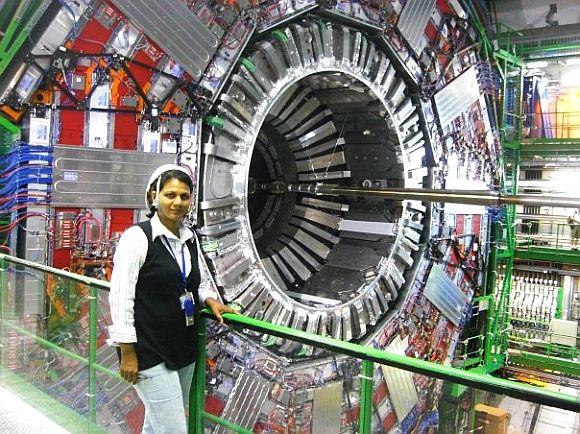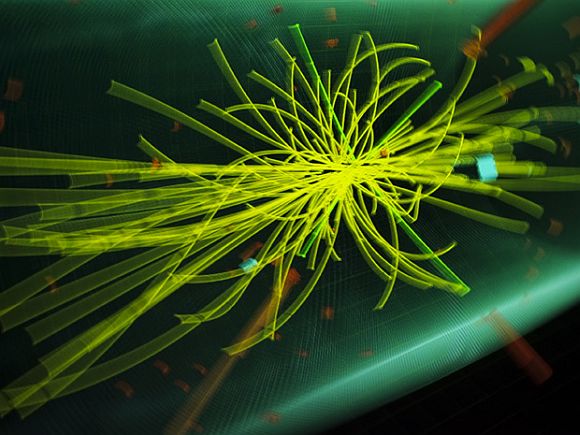 | « Back to article | Print this article |
Desi scientist part of God particle hunt speaks!
Scientists at the European Organization for Nuclear Research recently announced that they had spotted the key to solve the fundamental questions about the formation of the universe.
Part of the group of scientists was Archana Sharma, the only Indian scientist on the CERN staff based out of Geneva, Switzerland.
In a career spanning 23 years, Sharma, who did her Phd in Nuclear Physics from Delhi University in 1989, has pioneered in making CERN accessible to Indian students by facilitating student visits and providing prestigious internships in the world renowned facility.
In addition, she has also guided the likes of President Pratibha Patil and former President APJ Abdul Kalam in elaborating on the CERN facility and its mission.
In an interview with Sriram Balasubramanian, the permanent staff physicist at CERN details the magnitude of the biggest breakthrough in recent times.
What is the Higgs Boson particle experiment about? What do you think is the biggest achievement of this entire exercise?
The theory called the 'Standard Model' endeavours to explain all electromagnetic and nuclear reactions between particles. The model, derived in the 1970s, explains that the universe is completely comprised of matter (fermions) and force (bosons).
The brilliance of the 'Standard Model' is that it has been able to successfully explain nearly all experimental physics.
Particle physics is the study of the individual elements that comprise our universe. As most know, atoms are composed of smaller components; neutrons, electrons and protons. When electrons jump between atoms, new substances are formed, but the nucleus of an atom generally remains unchanged unless it undergoes a nuclear reaction.
The neutron/proton nucleus is also known as a hadron, which is made up of quarks. Quarks come paired in six different varieties; up and down, charm and strange, top and bottom. Quarks can also be classified as first, second, or third generation.
Click on NEXT to read further...
What's Higgs Boson after all?
According to the 'Standard Model', all matter consists of two different types of particles, quarks and leptons (i.e. electrons and neutrinos), held together by bosons. Bosons describe the force between particles.
There are three elementary bosons called gauge bosons; the photon (electromagnetic force), the W and Z boson (the weak force) and the gluons (the strong force). Then there are two additional suspected, yet unobserved, bosons, the Graviton and the Higgs.
The Higgs boson was originally suggested in the 1960′s by British physicist Peter Higgs.
Higgs postulated that a particle gains mass by passing through the Higgs field, a combination of an electromagnetic field and a solid. Before the Higgs portion of the 'Standard Model', it was assumed that W and Z bosons interacted with other elementary particles. However, the mass of those bosons was always so large that it unbalanced and broke the 'Standard Model'.
Thus, it was postulated that there had to be at least one other particle added to the mass equation, the Higgs boson. Ever since then the search has been on to find the elusive Higgs, leading to the construction of the LHC.
The LHC is the world's largest particle accelerator. In fact, it is the largest scientific equipment on the planet -- built by the CERN, and situated along the border between France and Switzerland.
LHC's sole purpose is to be a platform in which to test particle physics theories. It is run by engineers and scientists from hundreds of universities and laboratories from over a hundred different countries.
Click on NEXT to read further...
'Religion begins where science ends'
One of the main objectives of the LHC, since its conception, is to find the Higgs boson. So how might the Higgs boson have been found? The Higgs boson is known to be unstable, decaying into certain particles based on its expected weight.
The scientists designed their particle collision experiments in a way that will emit particles of a particular mass. If the particles within an expected range are more numerous than the collision alone can explain, then the rest of the observed particles are proof of the Higgs boson.
In addition to the science and physics achievements, a bigger achievement is meeting the technological and human challenge fighting with obsolescence over 20 years, working hand in hand with industry to find new solutions to questions bordering at the limits of knowledge and frontiers of understanding.
Does it reshape scientific theories that we have believed all this while? If so how?
Indeed the scientific theories build further on the body of work done by Copernicus, Galileo, Newton and Einstein and all observed physical phenomena. The direction was set, and this discovery, the pinnacle of physics in last 50 years.
Are these results a step forward in correlating religion and science with each other?
Religion begins where science ends. Science needs experimental corroboration, Spirituality, religion and philosophies are paved with uninhibited imagination.
Click on NEXT to read further...
'In the search for the Higgs, India has contributed in pivotal areas'
There has been a lot of hype around the 'God' particle. To my understanding, there has been some evidence of the existence of a particle that has the same characteristics of a particle that was needed to explain a theory that answered why some sub atomic particles like quarks have mass and why some like photons don't. Is there too much hype over this? Is this not the beginning of a long journey of discovery?
Well the evidence and discovery is the first of the series of the members of the Boson family, perhaps. Hence, being able to observe a particle at the energy it has been observed, opens new frontiers and unlocks doors unknown hitherto.
The particle itself is named after an Indian, Satyendranath Bose. How significant has been his contribution? How has India contributed to this experiment?
The word Boson itself bears witness to the fact that it is the Indian genius Prof Satyendranath Bose who together with Albert Einstein worked on the Bose-Einstein statistics.
In the search for the Higgs, India has contributed in pivotal areas: The accelerator machine itself -- corrector magnets and commissioning; in the CMS experiment hardware and software developments, installation and commissioning, and in the final stages -- data analysis.
Computing in itself with participation and contribution to the LHC Grid India has played a major role, and is set on enhancing this collaboration with CERN.
India spends over $2.5bn on science and technology by participating and contributing towards the so-called Mega Projects on the planet. Additionally, we produce 5,000 science doctorates per year, a vast resource. This would indeed imply a terra firma for harvesting rich rewards.
Click on NEXT to go further...
'We Indians have the grit and determination to make things work'
What can the common man or the students infer from research at CERN?
International collaborations at CERN for example, have been very successful in technology transfer, where research developments have led to applications in other fields.
A pioneering study carried out at CERN into the effect of the experience that technological industrial partners gain through working in the arena of mega science revealed variety of outcomes, which included technological learning, the development of new products and markets, and impact on the firm's organization.
Together, these findings implied ways in which CERN -- and by implication other mega science centres and projects -- could further boost technology transfer into spill-over benefits for industrial knowledge and enhance their contribution to industrial R&D and innovation.
Important signs of development of new businesses, products and services, and increased internationalization of sales and marketing operations (38 per cent new products and 60 per cent new customers) have resulted after the international exposure and direct contractual relationship.
Being an Indian, how do you feel being part of the entire CERN experience?
Amazing experience; I am incredibly privileged. I thank all my teachers who got me started first at the St Francis Convent in Jhansi, then Banaras Hindu University.
I would never have done nuclear/particle physics was it not for the outstanding set of teachers. We all (Indians) have the grit and determination to make things work, and albeit arduous, it has been a great journey. I am very proud, very Indian.
Click on NEXT to go further...
Top PHOTO features of the week
Click on MORE to see another set of PHOTO features...





